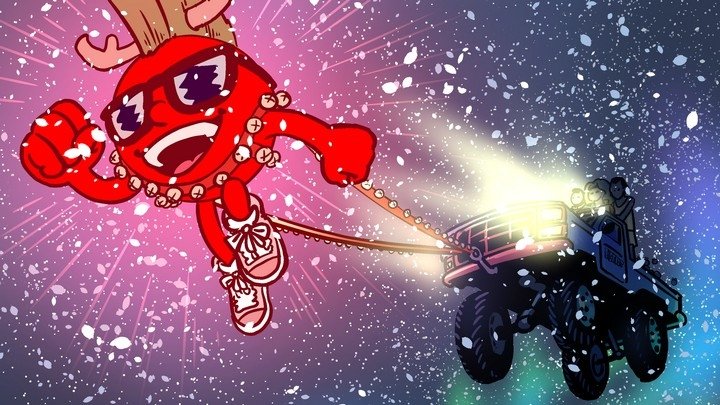How Sonic Mania redraws history before our eyes
As with the substance, the Taxman and company have both resurrected and improved upon the form.
Sonic Mania is finally out, and if you're a Sonic the Hedgehog fan who loved the old games—especially if you only enjoyed the old games—it absolutely is the continuation of that same spirit and quality you've been waiting for ever since 1994's Sonic 3 & Knuckles. As Kim alluded to in her review, the driving conceit of Mania during its development was to not only deliver yet another Sonic game as it would have arrived on the Genesis but to imagine how the classic formula might have been affected by the technological advances that immediately followed. In that respect, it's less like Mega Man 9, which strived to present itself as an authentic NES game made in 2008, and more like Shovel Knight, which Yacht Club Games made to look like an NES game if the system hadn't been replaced by the Super NES but had instead continued to see incremental increases to its capabilities in the form of mapper chips. More specifically, Sega et al. devised Sonic Mania as a Sega Saturn game that never was.
In reality, Sonic rather lost his way following Sega's 16-bit heyday, going dark for years amidst the disfunctional development and eventual cancellation of Sonic X-treme before finally making the jump to 3D a generation later in 1998's Sonic Adventure. At the time, Sega's flagship character bore the expectation of pushing the envelope in terms of technology, but in retrospect, it's easy to envision an alternate history where the series simply stuck to what worked and continued its initial streak of classic side-scrollers unabated into the 32-bit era, standing alongside such lush 2D games as Super Tempo and Princess Crown. This is just what Sonic Mania delivers, and while it takes no pains recreating the specific limitations of the Saturn (it features a higher display resolution and liberal use of transparencies, for one thing), it convincingly takes Sonic's original aesthetics and draws them one step into the future.

One significant aspect of this was the conscious decision to walk back some of the later revisions to the look of the characters and their world. The very first game, Sonic the Hedgehog, featured a whimsical visual style with scenery wrought in flat geometry bent off in sharp angles, and Sonic 2 and Sonic CD served up more of the same. By the time Sega got to Sonic 3, however, the next generation was already looming on the horizon, and they strained against the Genesis's capabilities to present something nominally more realistic. While Sonic's sprites in this game were merey edited from Sonic 2 rather than captured from high-poly 3D models as in Donkey Kong Country, Sega's artists were clearly aiming for a similar result, rounding off sharp edges and positioning highlights for a greater sense of dimension with a plastic veneer. Likewise, the stages were coated in a dense layer of semi-abstract visual noise and chaotically-assembled tiles to try to trick the eye into seeing something more detailed and naturalistic than it actually was.
This approach worked well enough at the time (especially with CRT monitors obscuring the image), but it's proven a bit less memorable than the iconic original style. Presenting stages as real locations became the series norm—even in throwbacks like Sonic 4 and Sonic Generations—but whether due to a revelation from Sega or the advisement of Christian Whitehead (who previously worked on rereleases of Sonic 1, 2, and CD), Sonic Mania wisely returns to surreal landscapes constructed out of pop art, as well as Sonic's sharper, cartoonier form. Interestingly, Knuckles, who debuted in Sonic 3, has also "reverted" to the same style despite never having used it originally.

After turning back the clock as such, Sonic Mania freely advances on its imagined future frontier, embellishing and refreshing familiar appearances with more storage capacity than could ever fit in a Genesis cartridge. This benefits the all-new stages most of all, as they could be designed from scratch around nigh-limitless color counts and more than enough VRAM to store unique pieces of large-scale background scenery. That said, the returning zones from previous games also enjoy their share—mainly in their second acts, which take a page from Sonic 3 and switch things up with new backgrounds and environmental gimmicks, such as the ziplines in Green Hill or the springy gelatin in Chemical Plant. The character sprites pop with vibrant 24-color palettes, and while Sonic and company retain many of their key poses from previous games, they animate much more fluidly, with the ability to scale and rotate and a downright decadent number of in-between frames for even the most incidental loops.

Mania's music largely returns to the new Jack swing sound from Sonic CD, with the occasional "Ooh!" sample mixed in to echo Michael Jackson's collaboration on Sonic 3. The synthesis of funk, electronica, and a touch of rap combines perfectly with the Memphis-inspired visuals to recall the creative zenith of the early '90s that gave birth to Sonic in the first place. Mania takes notes from Sonic CD in other places as well, from the traditionally animated opening to its 3D special stages; after all, the Sega CD embodied the promise of CD-ROM technology as gaming's future, so it's only right this imagined Saturn sequel would take what it started and raise it to the next level.
But Mania's developers were careful to only explore that "next level" and no further. The display isn't too high-res, and nearly all the graphics still take the form of traditional pixel art, which naturally keeps game's colors limited to a set of carefully-selected palettes. The special stages, while fully 3D, are wrought in primitive polygon structures reminiscent of early 32-bit titles. With the benefit of hindsight, Mania also sidesteps many of the pitfalls of that era's voracious pursuit of progress: There's no amateurish voice acting, dodgy pre-rendered graphics, or awkward CG movies choked with M-JPEG compression. Only the kitsch that serves the whole passes muster.

Sonic Mania revisits a moment in time partially defined by growing pains and missed opportunities, cherry-picks its greatest qualities, and essentially sets right what once went wrong. Many retro games endeavor to let us relive our memories, but it's a rare one indeed that reveals a glimpse of an even better past than the one we lived. It also marks the long-awaited return of the series' considered level design and nuanced physics, but even in terms of aesthetics alone, it represents a major accomplishment I'd be surprised to see repeated any time soon.




